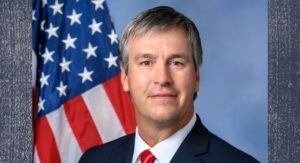Steve Flower: Census results are revealing

Well, folks, the final census figures are in from last year’s 2020 nose count. The census is taken every 10 years to determine the lines and boundaries of congressional and legislative districts. However, the census reveals a lot more information about us as a state and nation than just how many of us there are. It paints a picture of who we are as people and what we look like. The most recent census unveils an America much different than those of us who were born in the 1950s and are referred to as the “Baby Boomer” generation. We are one diverse country. Indeed, we are a true melting pot. The United States is now less than 60% white/Caucasian – 57% to be exact. The black/African American population has basically remained the same at about 12% of the population. The most remarkable figure is that 20% of our population identifies as Hispanic. The Asian population has doubled over the 10 years from 3% to 6% percent. It is a new America. What do these numbers portend, and what is the story for Alabama? First of all, we did an amazing job on our count. The Census Bureau has remarked that Alabama was one of the five best states in America when it came to counting our people. We actually came up with 103,000 more people than what was projected. Gov. Kay Ivey’s efforts deserve some credit for this success. The most significant fact in our successful count is that we saved a congressional seat. It had been projected for the last five years that we were going to lose a congressional seat from seven to six in Congress. We will, fortunately, keep seven. This will make the legislature’s job much, much easier when they meet in about a month to draw the lines. After the reapportionment session, we will still probably have six Republican congressmen and one Democratic member of Congress. In fact, when the members of the legislature begin drawing the lines, they will begin with that lone Democratic seat of Congresswoman Terri Sewell. She and that district will come first when dividing up people for two reasons. One is that Alabama is still under the eye of the Justice Department by virtue of the 1965 Voting Rights Act, whereby we must have at least one majority-minority district. Because the Black Belt region of the state has lost significant population, she will have to take in a larger area. She will probably go all the way from Birmingham to Mobile. She will pick up a large chunk of Tuscaloosa and almost all of Montgomery, as well as at least three to five more sparsely populated Black Belt counties on the way between Birmingham and Mobile. As projected, the Black Belt counties lost population, and the growth in the state was in fast-growing Republican-leaning counties such as Baldwin, Shelby, Jefferson, Lee, and especially in the Huntsville / Madison / Limestone area. The second reason that Congresswoman Sewell will get deference is that she is our only Democratic congressperson. With the U.S. House of Representatives being majority Democratic, as well as the White House, Congresswoman Sewell is our only conduit to the majority party. In addition, she is on a fast leadership track in Congress and sits on the all-important House Ways and Means Committee. Huntsville’s amazing growth is the remarkable story of the census in Alabama. Huntsville is now Alabama’s largest city. It far surpasses Birmingham. In fact, Birmingham lost 5% of its population. There is essentially a tie between Montgomery and Birmingham as to who is second. Montgomery held its own. Huntsville city grew by 20%. The metro area by over 40%. The Birmingham/Hoover metro area is still by far the largest metropolitan area. The suburban cities of Hoover, Vestavia Hills, and Trussville grew substantially. Hoover itself grew by 13%. After the Madison (Huntsville) / Limestone area, the fastest growing county in the state is Baldwin County. While Daphne had significant growth, the darling in the group is Fairhope, which grew by 47%. Lee County and Auburn grew by whopping numbers. What does this mean politically? These growth counties of Baldwin, Madison, and Lee will see increased Republican representation in the legislature, and the Jefferson/Shelby suburbs will hold their own. It will be hard to not increase the supermajority Republican control of the Alabama Senate and House of Representatives. See you next week. Steve Flowers is Alabama’s leading political columnist. His weekly column appears in over 60 Alabama newspapers. He served 16 years in the legislature. Steve may be reached at www.steveflowers.us.
Alabama drops lawsuit challenging Census privacy method

The state of Alabama on Thursday asked to dismiss its lawsuit challenging the U.S. Census Bureau’s use of a controversial statistical method aimed at keeping people’s data private in the numbers used for redrawing congressional and legislative districts. Alabama and three Alabama politicians had sued the Commerce Department, which oversees the Census Bureau, in an effort to stop the statistical agency from using the method known as “differential privacy.” They also wanted to force the bureau to release the redistricting numbers earlier than planned. Normally, the data is released at the end of March, but the Census Bureau pushed the deadline to August because of delays caused by the coronavirus pandemic. Alabama originally claimed the delay was caused by the bureau’s attempt to implement differential privacy, which the state’s attorneys said would result in inaccurate redistricting numbers. A three-judge panel in June refused to stop the Census Bureau from using the statistical method. In July, Alabama and the Commerce Department asked that the lawsuit be put on hold so that the state could decide how to proceed after the redistricting data was released in mid-August. “While we continue to believe that the Census Bureau’s production of intentionally skewed redistricting data half a year late was unlawful, dismissing the lawsuit now is in the state’s best interest to allow the Legislature to focus on redistricting based on the data it finally received,” Alabama Attorney General Steve Marshall said Thursday in a statement. Differential privacy adds intentional errors to the data to obscure the identity of any given participant in the 2020 census while still providing statistically valid information. The Census Bureau says more privacy protections are needed than in past decades as technological innovations magnify the threat of people being identified through their census answers, which are confidential by law. Two actions by the Census Bureau also alleviated some of the Alabama officials’ concerns. First, the statistical agency released the data in August, instead of September as previously planned. Then, it reduced the amount of error injected into the data, Marshall said. “Again, while not perfect, the resulting data Alabama received appears to be more accurate than it likely would have been had Alabama not drawn attention to the Bureau’s plans,” Marshall said. “Given these positive developments and the need to timely complete redistricting, dismissing the lawsuit at this stage makes sense.” Republished with the permission of the Associated Press.
Census Bureau to respond to Alabama lawsuit in fall

The federal government has until mid-November to respond to Alabama’s lawsuit seeking to exclude immigrants living in the country illegally from U.S. Census counts. A federal judge last week gave the U.S. Department of Commerce and Census Bureau an extension until Nov. 13 to reply to the lawsuit. Lawyers had said the Department of Justice components needed additional time to finish “evaluating the arguments that the government will make in this matter.” Alabama Attorney General Steve Marshall filed the lawsuit against the federal government in June. Marshall argues the immigrants should not be included in census counts used to distribute congressional district. The lawsuit contends Alabama is at risk to lose a congressional seat, and thus an electoral vote, to a state with a “larger illegal alien population.” Republished with permission from the Associated Press.
Latino voters seek to challenge Alabama Census lawsuit

Latino voters and civil-rights groups have asked to join a lawsuit to defend the practice of including people in the country illegally in U.S. Census counts. The counts are used to configure congressional seats. Alabama and Congressman Mo Brooks sued the Census Bureau and the U.S. Commerce Department in May, arguing the predicted 2020 Census numbers will cause the state to lose a congressional seat and an electoral vote to a state with a “larger illegal alien population.” It has been a longstanding practice to include all U.S. residents, including noncitizens regardless of immigration status, in the census, which also determines the number of congressional seats for each state. In 2016, the U.S. Supreme Court ruled against two Texas residents who argued their votes were diluted by the practice of using the “whole population” to draw legislative district lines. Alabama is seeking to have the practice declared unconstitutional. The state argues it violates existing statutes that “require a census enumeration of the total of legally present resident population.” The Mexican American Legal Defense and Educational Fund filed a motion on Thursday on behalf of six voters and the group Chicanos Por La Causa, which are seeking to join the case as defendants. They say they live in states, including California, Florida, Texas, and Arizona, that could lose congressional seats and federal funding if the count doesn’t include all residents. They fear the federal government will not fight for their interests in the case because it has “no specific incentive to defend the use of a particular population base” when it comes to configuring congressional seats. Instead, the motion says, the government’s stake is limited to defending the criteria and procedures used by the Census Bureau. The federal government is charged with “representing varied public and administrative interests,” the motion says. The voters and civil rights groups, on the other hand, are interested in protecting “their private interests in political access and representation” and the apportionment standard that is currently in place. Republished with the permission of the Associated Press.
Judge lets challenge to census citizenship query go forward

A federal judge ruled Tuesday that a legal challenge to the 2020 census can go forward, saying there was an appearance of “bad faith” behind the Trump Administration’s disputed decision to add a question about citizenship. U.S. District Judge Jesse Furman made the ruling at a hearing in federal court in Manhattan after citing contradictory statements by Commerce Secretary Wilbur Ross about the rationale for a plan to send a census form to every household that asks people to specify whether they are U.S. citizens. The move has fueled worries among Democrats that it will discourage immigrants from participating in the survey, thereby diluting representation for states that tend to vote Democratic and robbing many communities of federal dollars. A coalition of about two dozen states and cities have sued the U.S. government in New York to block the plan, calling it unconstitutional. Ross, who oversees the census, had originally said he wanted the citizenship question asked for the first time since 1950 at the behest of the Justice Department so it could better enforce the Voting Rights Act. But in a court filing, Ross later said he came up with the idea in consultation with various government officials before seeking DOJ support for it. Furman ruled from the bench that lawyers for the states and cities had “made a strong showing of bad faith” by the federal government, and could begin deposing officials over how the decision was reached. He told them to start with lower-level officials first, then consult him if they want to question Ross. The judge also put off a decision on a government request to throw out the suit, but called it “unlikely” that would happen. In a statement, New York Attorney General Barbara Underwood hailed the ruling as a major step toward upholding the government’s “solemn obligation to ensure a fair and accurate count of all people in this country.” There was no immediate response to a message seeking comment from the Commerce Department. Brett Shumate, a deputy assistant attorney general, argued on Tuesday that the plaintiffs were relying on a “speculative chain of inferences” to support the suit’s claim that adding the citizenship question would result in an “undercount” of people. The government has ways to ensure an accurate census, he said. The commerce secretary “has those procedures in place and plans to count every person in America,” he said. In court papers, the plaintiffs have said that the Census Bureau’s own research suggests that participation by Hispanics and other immigrants would decline if there’s a citizenship question. Republished with the permission of the Associated Press.
Alabama, Mo Brooks sue over inclusion of illegal aliens in US Census

Alabama 5th District U.S. Rep. Mo Brooks and Alabama Attorney General Steve Marshall have filed a lawsuit against the federal government over what they said was the Census Bureau‘s “unlawful” decision to include of illegal immigrants in census data “used to determine the apportionment of the U.S. House of Representatives and the Electoral College.” Marshall says the move will cause Alabama to lose a seat in the U.S. House of Representative as well as a vote in the Electoral College. “If the U.S. Census Bureau follows through with its plan to include illegal aliens in the 2020 census for purposes of apportionment, Alabama will lose both a seat in the U.S. House of Representative and a vote in the Electoral College,” explained Marshall. “Alabama’s loss will be another state’s gain, as states with a growing illegal alien population will be the beneficiary of this reapportionment. I have joined with Congressman Mo Brooks in filing suit against the federal government to stop the inclusion of illegal aliens in the census’s apportionment population. The Constitution does not permit the dilution of our legal residents’ right to equal representation in this manner.” Brooks echoed Marshall’s thoughts. “Each decade, 435 Congressional seats are apportioned among the states based on population. Congressional seats should be apportioned based on the population of American citizens, not illegal aliens. After all, this is America, not the United Nations,” said Brooks. Brooks says there are roughly fifteen million illegal aliens in America (no one knows for sure the exact number), which would mean roughly 20 Congressional seats would be taken from low-illegal alien population states and given to high-illegal alien population states like California. “As of today, Alabama likely loses a Congressional seat after the 2020 census if apportionment includes illegal alien counts. The loss of an Alabama Congressional seat will be a huge loss in Alabama’s political influence and will diminish Alabama’s influence in Congress and its importance in presidential elections,” Brooks continued. “This lawsuit will have significant and enduring effects on Alabama and other states harmed by unconstitutional census methods. Fundamentally, the issue is fair and equal representation for United States citizens. While some stand for illegal aliens, I stand for American citizens.” In their lawsuit, Marshall and Brooks argue the Census Bureau’s “Residence Rule” — which allows foreign nationals living in the United States to be counted in the census and allocated to the state of their “usual residence” regardless of whether they are legally present in the U.S. — violates the Fourteenth Amendment of the U.S. Constitution and the constitutional principal of equal representation: “The Residence Rule breaches the federal government’s constitutional obligation to conduct an ‘actual Enumeration’ of the number of ‘persons in each State.’ The phrase ‘persons in each State’ was understood at both the Founding and in the Reconstruction era to be restricted to aliens who have been lawfully admitted to the body politic constituted by the Constitution. Aliens who are unlawfully present in the United States did not qualify because they are not entitled to political representation. Thus, the actual enumeration of the population cannot include such aliens.” Alabama is not alone in being adversely affected by the Census Bureau’s decision to include illegal aliens in the apportionment calculation. Ohio is likely to lose a congressional seat and an electoral vote, and Montana will not gain a congressional seat and an electoral vote it would have acquired if illegal aliens were excluded from the 2020 census and the apportionment base. The State of Alabama’s lawsuit against the U.S. Department of Commerce and the Census Bureau was filed May 21, 2018, in the U.S. District Court for the Northern District of Alabama. Click HERE to view the lawsuit. Watch Brooks’ House floor speech making the announcement below:
Donald Trump hails border wall start, but it’s not quite true

President Donald Trump hailed the start of his long-sought southern border wall this past week, proudly tweeting photos of the “WALL!” Actually, no new work got underway. The photos showed the continuation of an old project to replace two miles of existing barrier. And on Saturday, he ripped Amazon with a shaky claim that its contract with the post office is a “scam.” Trump and his officials departed from reality on a variety of subjects in recent days: the census, Amazon’s practices and the makeup of the Supreme Court among them. Here’s a look at some statements and their veracity: TRUMP: “Great briefing this afternoon on the start of our Southern Border WALL!” — tweet Wednesday, showing photos of workers building a fence. TRUMP: “We’re going to be starting work, literally, on Monday, on not only some new wall — not enough, but we’re working that very quickly — but also fixing existing walls and existing acceptable fences.” — Trump, speaking the previous week after signing a bill financing the government. THE FACTS: Trump’s wrong. No new work began on Monday or any other time this past week. And the photos Trump tweeted were misleading. They showed work that’s been going on for more than a month on a small border wall replacement project in Calexico, California, that has nothing to do with the federal budget he signed into law last week. The Calexico project that began Feb. 21 to replace a little more than 2 miles (3.2 kilometers) of border wall was financed during the 2017 budget year. A barrier built in the 1990s mainly from recycled metal scraps is being torn down and replaced with bollard-style barriers that are 30 feet (9.1 meters) high. Ronald D. Vitiello, acting deputy commissioner of U.S. Customs and Border Protection, defended the president’s statements, saying Friday “there’s construction” underway. TRUMP: “If the P.O. ‘increased its parcel rates, Amazon’s shipping costs would rise by $2.6 Billion.’ This Post Office scam must stop. Amazon must pay real costs (and taxes) now!” — tweet Saturday. TRUMP: “I have stated my concerns with Amazon long before the Election. Unlike others, they pay little or no taxes to state & local governments, use our Postal System as their Delivery Boy (causing tremendous loss to the U.S.), and are putting many thousands of retailers out of business!” — tweet Thursday. THE FACTS: Trump is misrepresenting Amazon’s record on taxes, the U.S. Postal Service’s financial situation and the contract that has the post office deliver some Amazon orders. Federal regulators have found that contract to be profitable for the Postal Service. People who buy products sold by Amazon pay sales tax in all states that have a sales tax. Not all third-party vendors using Amazon collect it, however. As for the post office, package delivery has been a bright spot for a service that’s lost money for 11 straight years. The losses are mostly due to pension and health care costs — not the business deal for the Postal Service to deliver packages for Amazon. Boosted by e-commerce, the Postal Service has enjoyed double-digit increases in revenue from delivering packages, but that hasn’t been enough to offset declines in first-class letters and marketing mail, which together make up more than two-thirds of postal revenue. While the Postal Service’s losses can’t be attributed to its package business, Trump’s claim that it could get more bang for its buck may not be entirely far-fetched. A 2017 analysis by Citigroup concluded that the Postal Service was charging below-market rates as a whole for parcels. The post office does not use taxpayer money for its operations. Trump is upset about Amazon because its owner, Jeff Bezos, owns The Washington Post, one of the targets of his “fake news” tweets. TRUMP: “Because of the $700 & $716 Billion Dollars gotten to rebuild our Military, many jobs are created and our Military is again rich. Building a great Border Wall, with drugs (poison) and enemy combatants pouring into our Country, is all about National Defense. Build WALL through M!” — tweets Sunday and Monday. THE FACTS: Trump is floating the idea of using “M″ — the Pentagon’s military budget — to pay for his wall with Mexico. Such a move would almost certainly require approval from Congress and there’s plenty of reason to be skeptical about the notion of diverting military money for this purpose. Only Congress has the power under the Constitution to determine federal appropriations, leaving the Trump administration little authority to shift money without lawmakers’ approval. Pentagon spokesman Chris Sherwood referred all questions on the wall to the White House. Spokeswoman Sarah Huckabee Sanders declined to reveal specifics, but said Trump would work with the White House counsel to make sure any action taken was within his executive authority. DAVID SHULKIN, citing reasons Trump fired him as veterans affairs secretary: “I have been falsely accused of things by people who wanted me out of the way. But despite these politically based attacks on me and my family’s character, I am proud of my record and know that I acted with the utmost integrity.” — op-ed Thursday in The New York Times. THE FACTS: His statement that he and his family were subjected to politically based attacks is disingenuous, though politics contributed to his dismissal. White House support for Shulkin eroded after a blistering report in February by VA’s internal watchdog, a non-partisan office. The inspector general’s office concluded that he had violated ethics rules by accepting free Wimbledon tennis tickets. The inspector general also said Shulkin’s chief of staff had doctored emails to justify bringing the secretary’s wife to Europe with him at taxpayer expense. It is true, though, that Shulkin had encountered resistance from about a half-dozen political appointees at the VA and White House who rebelled against him. In an extraordinary telephone call, John Ullyot, a top communications aide, and VA spokesman Curt Cashour asked the Republican staff director of the House Veterans Affairs Committee to push for Shulkin’s
Counting Americans: A new Mideast box on census is sensitive

Zahraa Ballout isn’t “white,” and she certainly isn’t “some other race.” If the government gives her the choice of checking a new “Middle East/North Africa” box on a census form, would she? Yes, she says, despite some reservations about what it would mean to stand out after Americans elected a president who wants to ban travel from some countries in the region and has spoken favorably of registering Muslims in the U.S. “I would feel some wariness because you don’t know exactly the consequences or what’s coming next after you check the box,” says 21-year-old Ballout, a student in Dearborn, Michigan, who’s been in the country three years. “I don’t want to fool myself to think that checking another box (other than the new one) is going to protect me in some way.” Ballou’s risk-benefit analysis reflects a new caution surrounding the way the U.S. government counts Americans, an every-decade exercise mandated in the Constitution that influences the nation’s day-to-day operations in ways big and small. That includes representation in Congress and how taxpayer money is doled out – for education, public health, transportation and more. The Census Bureau on Feb. 28 for the first time recommended including the new category, which would mostly affect Muslims. The Office of Management and Budget is expected to make the decision later this year. The move is the product of years of research and decades of advocacy for Arab and other groups from the region that pre-date Donald Trump‘s presidential campaign. The Census Bureau said that when it tested a new MENA category in 2015, people of Middle Eastern or North African descent tended to check off that box. When it wasn’t there, they’d select “white” or, increasingly, “some other race.” Including the separate category, the agency said, is “optimal” to get a more accurate count of Americans. “There’s nothing for me to hide,” said Hussein Dabajeh, 30, a lifelong Dearborn resident who said his ancestors arrived from what’s now Lebanon in 1911. Dabajeh says he’d check the MENA box. “I can be American of Arab descent without being un-American.” The disparity can be seen in a basic statistic. The Arab American Institute estimates as many as 3.7 million people in the United States have Arab roots. The Census Bureau estimates there are 1.8 million Arab Americans in the U.S, according to data it has collected. Among other things, that means there are no accurate national numbers to provide clues to whether certain medical ailments are – as suspected – unusually common in people of that background, experts say. Both tallies show explosive growth in that population since 2000. And both support the new box on the 2020 census that would represent people with backgrounds from 19 countries in the region. But singling oneself out in that way has become sensitive at a time when Trump has linked a crackdown on Muslims with better national security. As a candidate, he called for a “total and complete shutdown of Muslims entering the United States.” As president, Trump has twice ordered travel bans on people from certain majority-Muslim nations. Federal courts have blocked those orders, but on Friday, the Trump administration said it would appeal the latest ruling. In 2016, Trump said the government should investigate mosques in the U.S. in much the same way the New York Police Department’s now-shuttered “Demographics Unit” spied on Muslims with help from the CIA. The group assembled databases on where Muslims lived, shopped, worked and prayed, infiltrated Muslim student groups, put informants in mosques and monitored sermons, The Associated Press reported in 2011. “The fear is legitimate. It’s something I worry about,” said Maya Berry, executive director of the Arab American Institute, which has been pushing for the change since before the 1990 census, when it put up posters reading, “We want to be counted, do you?” “It’s very hard for us now to sort of reject that wholly, because we’ve been working on it for decades,” she adds. “We’ve been telling our members: We understand why you’re concerned, it’s a legitimate concern. Let’s just proceed with caution.” Former Census director Robert Groves traces the worries in part to one “black mark” on the department’s history. During World War II, the Census Bureau provided the government with neighborhood information to help it sweep up 120,000 people of Japanese descent for imprisonment, under an order by President Franklin D. Roosevelt. But he points out that the law prohibits workers from disclosing personal census information. “The culture of the Census Bureau and this law has been successful over successive decades in allowing me and others to say this is the best protection that can be given to people,” said Groves, now provost of Georgetown University. While some members of the MENA community share the concerns, they also believe the government is powerful enough to discriminate against anyone. “There are better ways to do that than the census,” said Germine Awad, a University of Texas psychologist born in Egypt but raised in the United States. “That could happen at any moment.” Republished with permission of The Associated Press.
Nearly half of states expect to confront big budget gaps

With the nation’s economy at its healthiest since the Great Recession, a surprising trend is emerging among the states — large budget gaps. An Associated Press analysis of statehouse finances across the country shows that at least 22 states project shortfalls for the coming fiscal year. The deficits recall recession-era anxiety about plunging tax revenue and deep cuts to education, social services and other government-funded programs. The sheer number of states facing budget gaps prompted Standard & Poor’s Ratings Service to call the trend a sort of “early warning.” “After all, if a state is grappling with a budget deficit now, with the economic expansion approaching its sixth anniversary, what will be its condition when the next slowdown strikes?” credit analyst Gabriel Petek wrote in a recent report. The forces at work today are somewhat different than when the recession took hold in 2008. In some states, revenue growth has been stagnant, missing projections and making it difficult to keep pace with expanding populations and rising costs for health care and education. Other states have been hurt by a steep decline in oil prices or have seen their efforts to promote growth through tax cuts fail to work as anticipated. The result is a nation divided between states such as California and Colorado that are riding the wave of the economic recovery and others such as Illinois and Pennsylvania that appear closer to bust than boom. A majority of states have failed to climb back to their pre-recession status, in terms of tax revenue, financial reserves and employment rates, said Barb Rosewicz, who tracks the fiscal health of states for The Pew Charitable Trusts. Alabama, for example, faces a $290 million shortfall after a voter-approved bailout expires at the end of the current fiscal year. Projected cuts would create a $27 million hole in the state’s court system, forcing more than 600 layoffs and leaving just one juvenile probation officer and two clerical staffers in each county, said Rich Hobson, administrative director for the Alabama Unified Judicial System. If nothing is done, the courts will not have the staff to send jury notices, monitor juvenile delinquents, process protection orders and collect and distribute child support payments, he said. “This is an insane proposition,” Hobson said. “The public would suffer.” To avoid the cuts, Republican Gov. Robert Bentley has proposed raising $541 million through increases in the tobacco tax and sales taxes on automobiles. A top Republican in the Alabama Senate has introduced a gambling bill that would ultimately ask voters to decide whether to create a state lottery and allow four casinos. Lawmakers in some other states, including Nevada, Connecticut and Pennsylvania, have also debated whether to raise taxes. Nationally, total tax revenue coming to the states has been rising, but the pace has been slow as employment continues to lag pre-recession levels in more than half the states, according to the Pew Charitable Trusts. Pew also found that 30 states are collecting less revenue than at their peak. “What we are seeing across states right now is an economic and financial recovery that is a little bit different than the recoveries we’ve seen in the past,” said Emily Raimes, a vice president with Moody’s Investors Service who tracks state government finances. Previous recoveries were broader, she said, benefiting more states and allowing them to replenish their financial reserves. The Census Bureau recently reported that total state government tax collections in fiscal year 2014, which in most states ended last June, increased 2.2 percent over the previous fiscal year. That represented the fourth consecutive overall increase, but 17 states reported declines in tax revenue from the previous fiscal year, according to the report. Alaska saw the biggest drop, of $1.7 billion. Alaska relies heavily on oil revenue and projects a $3.2 billion budget shortfall for the coming fiscal year. A special legislative session has been called after lawmakers failed to agree on a way to fund the budget, even though the state has plenty of money in reserves to cover the gap. That’s not the case in Illinois, where lawmakers are trying to figure out how to close a $6 billion projected shortfall for the next fiscal year, largely because of the expiration of a temporary tax increase. Republican Gov. Bruce Rauner, who campaigned against the tax plan, has suggested cuts to health care, local governments and other areas. But lawmakers in the Democratic-led General Assembly say spending cuts alone will not close the gap. In Kansas, the Republican governor and GOP-dominated Legislature now confront budget deficits after aggressive tax cutting that prompted them to reduce school funding this spring. Districts across the state have cut staff and programs such as summer school, and at least eight are ending the current school year early to save money. That includes the Shawnee Heights district outside Topeka, where students will begin their summer break two days early. Lawmakers passed a new school funding law that promises the money will be restored and state aid will rise each of the next two fiscal years, but educators are skeptical. “There’s no rational person in education who would think we’ll be getting that money, when the state budget is tanking,” said Charles Walther, a middle school history, government and geography teacher who heads the district union. Republished with permission of The Associated Press.
Census data shows great strides for women, but much more left to do
In the past four decades, there has been a number of changes in American society and culture. However, for women in the U.S., some things have stayed much the same, according to Census Bureau data released in advance of National Women’s History Month. National Women’s History Month began in March 1857, when women from New York City factories staged a protest over working conditions. International Women’s Day, first observed in 1909, led to Congress establishing National Women’s History Week, commemorated the second week of March. By 1987, Congress expanded the week-long celebration to a month, celebrated in March. As for women in today’s workforce, numbers show significant gains, while others show much work left to do. By way of sheer numbers, women’s participation in the labor force has increased considerably, from 30.3 million in 1970 to 75.1 million females 16 and older who participated in the civilian labor force in 2013. Women made up 37.97 percent of the 1970 labor force, jumping to 47.4 percent of the civilian labor force in 2013. Particular occupations have also seen a sharp increase in women workers. Census data had shown little participation from women in 1970 as accountants, police officers, lawyers and judges, physicians and surgeons, and pharmacists. By 2006-2010, women made considerable gains in those fields – with particularly strong presence as accountants (60 percent). Of the STEM (science, technology, engineering, and math) fields, 63 percent of social scientists are women, the heaviest representation of women among all. Among other STEM fields, about 14 percent of engineers, 45 percent of mathematicians and statisticians and 47 percent of life scientists were women. On the other hand, growth in certain segments of the workforce has slowed for women. The largest gain in women’s workforce participation occurred between 1970 and 1980, followed by a slowdown. An increase of only 0.4 percentage points occurred in the period leading up to 2006-2010. Compare that growth rate to a peak of 4.3 percentage points in the 1970s. Several occupations are overwhelmingly female. For example, women make up 96.3 percent of dental assistants, 95.9 percent of secretaries and 91.2 percent of registered nurses. Those standings have changed the least in the past 40 years. In 1970, secretaries, bookkeepers, and elementary school teachers were primarily women. In 2006-2010, those women-led occupations were secretaries and administrative assistants, cashiers, and elementary and middle schoolteachers. One explanation is the sheer numbers of jobs available; there are more jobs out there for elementary and middle school teaching positions than (as an example) surgeons. In comparison, the leading jobs for men remain the same as back in 1970: miscellaneous managers, truck drivers, and production supervisors. Four decades later, it is truck drivers, various managers, and freight, stock, and material movers. Researchers say the increase in female participation in the workplace started with the economics of the 1970s, beginning when a single-income household could no longer support a middle-class lifestyle. Gender wage gap remained a major issue in 2014; the Census found that year-round, full-time female workers earned 78¢ in 2013 for every dollar their male counterparts earned. Those numbers are not statistically different from 2012. [Source: U.S. Census Bureau]


